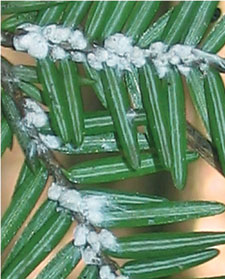 A Japanese insect called the hemlock woolly adelgid has devastated Southern Appalachian hemlock forests, but apparently not to the degree expected, new research shows.
A Japanese insect called the hemlock woolly adelgid has devastated Southern Appalachian hemlock forests, but apparently not to the degree expected, new research shows.
The U.S. Forest Service released a study Wednesday that says the majestic trees might still be growing fast enough in the East to offset the insect's damage.
The adelgid was first spotted in Virginia in the 1950s. By 1980, damage had begun in the hemlock's Appalachian range running from northern Georgia to Canada. Trees were hit hardest in the South, where mild winters don't help limit the insect's spread.
Lead author Talbot Trotter, an ecologist at the service's Northern Research Station in Pennsylvania, says the study might have captured a tipping point between hemlock losses and increases due to forest regrowth. The study used forest data only through 2007.
"Repeating this analysis as new (forest) data becomes available may show if we are beyond a tipping point and are now losing hemlock," he said.
Thursday, January 23, 2014
Are insect-ravaged hemlocks at a tipping point?
Subscribe to:
Post Comments (Atom)








11 comments:
Sure would be great if we didn't lose get another enormous batch of trees!
Whatever happened to acid rain? 'Member back in the 80s and 90s when these dying hemlocks became the poster child as "proof" of acid rain? Even the informational signs at Clingman's Dome finally had to be revised when the true cause was determined. But by then it was too late, the meme was ubiquitous. There are folks today who still think those trees are being killed by "acid rain."
Just curious what this has to do with the current problem they are a facing from the Adelgid?
Anon. from Anon. Re Pete. It is obvious how they are related. Because scientists were wrong (which actually they weren't entirely)on the effects of acid rain, they must be wrong now. The link is killing trees. Same issue - wrong on one, must be wrong on the other. It seems to me that's how Pete sees it.
I thought the concern with acid rain was with the balsam firs at the highest elevations.
Don't confuse Pete with facts.
The USDA thought they would solve this by introducing a multi-colored Asian lady beetle which would eat these guys. All it did was create enormous swarms of lady beeles all over the country! They get in your house, all over your walls, into your drawers, everywhere and they stink! And don't think about an exterminator, its illegal to kill them!
"I thought the concern with acid rain was with the balsam firs at the highest elevations."
Anon. to Anon. The trees at the top are/were Frazier firs and red spruce. The Frazier firs have been dramatically killed off by the balsam wolley adelgid, likely. But, the acid rain, so others say, was a contriubting factor to weakening the trees. The research and study is ongoing.
"The USDA thought they would solve this by introducing a multi-colored Asian lady beetle which would eat these guys. All it did was create enormous swarms of lady beeles all over the country! They get in your house, all over your walls, into your drawers, everywhere and they stink! And don't think about an exterminator, its illegal to kill them!"
Anon. to anon. The orange and black lady bugs to which you refer are not the ones that folks are trying to introduce to combat the hemlock wooley adelgids. Those are much smaller, black lady bugs which are from the far east and expensive to bring in. So far they have not have grown to a population that can control the adelgids. Yes, the orange and black lady bugs do get into home and are a nuisance. Please tell me exactly what state law or regulation says you can't kill these buggers? By the way, when I clean them out of my house they are already dead.
Acid rain does tend to weaken the trees so that a negative compounding effect takes place. Only in America do we look for the ONE cause of everything as if we are too stupid to understand the impact of multiple negative factors. The upper elevation balsams, hemlocks, and firs have been negatively impacted by many factors. As one who has hiked the Appalachian Trail and the mountain portion of the Mountains to Sea Trail in NC, I hiked through entire stands of dead trees. The clowns who post inferring that this is somehow "the way things should be" b/c there is not one causal factor need to get their simple "banjo boy" Deliverance genetically inbred head examined. Oh by the way, the earth is flat, the moon landing was faked, and the illuminati control everything according to these folk too.
anonymous 7:10
Let me guess, all those hikes are alone.
Post a Comment